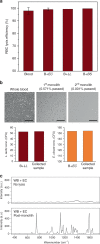Isolation of intact bacteria from blood by selective cell lysis in a microfluidic porous silica monolith
- PMID: 31240109
- PMCID: PMC6572753
- DOI: 10.1038/s41378-019-0063-4
Isolation of intact bacteria from blood by selective cell lysis in a microfluidic porous silica monolith
Abstract
Rapid and efficient isolation of bacteria from complex biological matrices is necessary for effective pathogen identification in emerging single-cell diagnostics. Here, we demonstrate the isolation of intact and viable bacteria from whole blood through the selective lysis of blood cells during flow through a porous silica monolith. Efficient mechanical hemolysis is achieved while providing passage of intact and viable bacteria through the monoliths, allowing size-based isolation of bacteria to be performed following selective lysis. A process for synthesizing large quantities of discrete capillary-bound monolith elements and millimeter-scale monolith bricks is described, together with the seamless integration of individual monoliths into microfluidic chips. The impact of monolith morphology, geometry, and flow conditions on cell lysis is explored, and flow regimes are identified wherein robust selective blood cell lysis and intact bacteria passage are achieved for multiple gram-negative and gram-positive bacteria. The technique is shown to enable rapid sample preparation and bacteria analysis by single-cell Raman spectrometry. The selective lysis technique presents a unique sample preparation step supporting rapid and culture-free analysis of bacteria for the point of care.
Keywords: Engineering; Materials science.
Conflict of interest statement
Conflict of interestThe authors declare that they have no conflict of interest.
Figures






Similar articles
-
Lysis of gram-positive and gram-negative bacteria by antibacterial porous polymeric monolith formed in microfluidic biochips for sample preparation.Anal Bioanal Chem. 2014 Sep;406(24):5977-87. doi: 10.1007/s00216-014-8028-9. Epub 2014 Jul 25. Anal Bioanal Chem. 2014. PMID: 25059724
-
Ex Situ Integration of Multifunctional Porous Polymer Monoliths into Thermoplastic Microfluidic Chips.Sens Actuators B Chem. 2014 Oct 31;202:866-872. doi: 10.1016/j.snb.2014.06.023. Sens Actuators B Chem. 2014. PMID: 25018587 Free PMC article.
-
Cell lysis and DNA extraction of gram-positive and gram-negative bacteria from whole blood in a disposable microfluidic chip.Lab Chip. 2009 Oct 7;9(19):2811-7. doi: 10.1039/b905065p. Epub 2009 Jun 29. Lab Chip. 2009. PMID: 19967118
-
Less common applications of monoliths: I. Microscale protein mapping with proteolytic enzymes immobilized on monolithic supports.Electrophoresis. 2006 Mar;27(5-6):947-61. doi: 10.1002/elps.200500661. Electrophoresis. 2006. PMID: 16470758 Review.
-
New horizons in developing cell lysis methods: A review.Biotechnol Bioeng. 2022 Nov;119(11):3007-3021. doi: 10.1002/bit.28198. Epub 2022 Aug 5. Biotechnol Bioeng. 2022. PMID: 35900072 Review.
Cited by
-
Advances in Microfluidics for Single Red Blood Cell Analysis.Biosensors (Basel). 2023 Jan 9;13(1):117. doi: 10.3390/bios13010117. Biosensors (Basel). 2023. PMID: 36671952 Free PMC article. Review.
-
Numerical and Experimental Study of Cross-Sectional Effects on the Mixing Performance of the Spiral Microfluidics.Micromachines (Basel). 2021 Nov 29;12(12):1470. doi: 10.3390/mi12121470. Micromachines (Basel). 2021. PMID: 34945321 Free PMC article.
-
Raman-Activated, Interactive Sorting of Isotope-Labeled Bacteria.Sensors (Basel). 2024 Jul 11;24(14):4503. doi: 10.3390/s24144503. Sensors (Basel). 2024. PMID: 39065901 Free PMC article.
-
A Rapid Single-Cell Antimicrobial Susceptibility Testing Workflow for Bloodstream Infections.Biosensors (Basel). 2021 Aug 22;11(8):288. doi: 10.3390/bios11080288. Biosensors (Basel). 2021. PMID: 34436090 Free PMC article.
-
Rapid detection and identification of bacteria directly from whole blood with light scattering spectroscopy based biosensor.Sens Actuators B Chem. 2021 Nov 1;346:130489. doi: 10.1016/j.snb.2021.130489. Epub 2021 Jul 24. Sens Actuators B Chem. 2021. PMID: 34483482 Free PMC article.
References
LinkOut - more resources
Full Text Sources
Other Literature Sources
